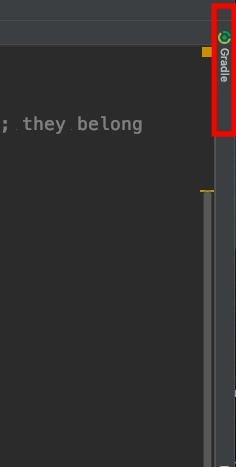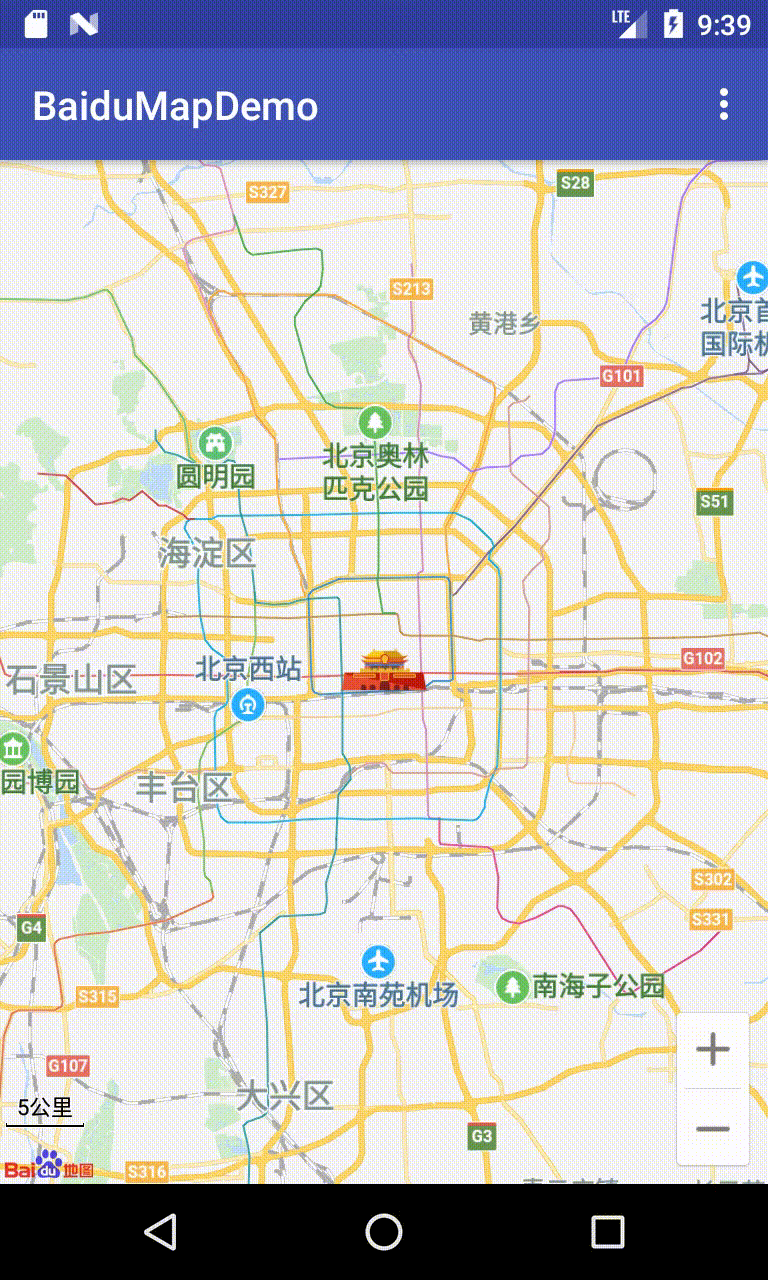Android進階:步驟四:Android 接入百度地圖API 基礎實現
內容概括:
- 註冊申請百度地圖開發平臺賬號 這裡是地址 如何申請百度地圖的賬號也有官方文件:在這裡
- 申請祕鑰(AK)、快速獲取釋出版SHA1和測試版SHA1和包名
- (文件裡面也有如果建立應用以及申請的教程,但在Android Studio中實現更加簡單)
- 百度地圖的Android Studio的配置
- app上實現百度地圖的基礎功能
- app實現切換百度地圖的型別(基本和衛星地圖)
- 實現定位功能
- 顯示附近商家
一、建立接入百度地圖的應用 這裡是連結 必須先註冊驗證成功
1.下面建立應用的介面
2.應用名稱隨意:我這裡填寫baiduMap
3.我們選擇應用型別為Android SDK
4.啟動服務預設全選就好
5.釋出版SHA1和測試版SHA1是什麼?怎麼簡單獲取這才是重點
也就是所謂的debug版本和release版本的數字簽名,這裡不做過多解析,一種加密演算法來保證app安全的。

怎麼簡單獲取應用的釋出版SHA1和測試版SHA1?
我們開啟Android Studio新建一個工程(命名為BaiduMapDemo)
注意紅色框框內就是我們這個應用的包名可以修改:我這裡寫的是
包名:com.demo.baidumap
其他設定預設,建立成功。

建立好工程後,我們找到Gradle Scripts
1.點選工程下的build.gradle

2.點選螢幕右邊隱藏一個側邊區域(Gradle)

3.如果點選後出現的是空白頁面點選,藍色按鈕就會出現了

4.那麼找到,android包下的signingReport 雙擊(雙擊)
雙擊後再AS的下面Run介面 就會出現

5.我們要的測試版(debug)的SHA1在這裡了
這個就是測試版的SHA1:
SHA1: DA:6C:6E:D6:09:98:8B:7D:1C:93:47:03:EC:C2........省略
---------- Variant: debug Config: debug Store: /Users/mac/.android/debug.keystore Alias: AndroidDebugKey MD5: 91:83:72:3C:C4:74:5A:8D:99:28:59:BE:90:A0:10:C8 SHA1: DA:6C:6E:D6:09:98:8B:7D:1C:93:47:03:EC:C2........省略 Valid until: 2048年3月1日 星期日 ----------
6、怎麼獲取釋出版的SHA1
1.Build——>Generate Singed APK

2.預設app即可,next

3.點選create new...

4.第一個是你存放檔案的路徑,注意: 字尾名是.keystore (因為它要生成一個.keystore的檔案)
password 自定 我這裡是android 所有都設定成了android 要記下這個密碼,下面的填寫任意
填寫完成點選OK


不需要點選next,這時候你存放的路徑就有一個.keystore檔案了

6.拿到.keystore檔案後,開啟終端
複製這行命令:
keytool -list -v -keystore
空一個格,將你的.keystore檔案拉進終端,就會自動識別它所在的路徑
enter鍵,後提示輸入輸入金鑰庫口令: 就是上面那個密碼 我這裡是android

7.輸入密碼之後,就會出現釋出版的SHA1了

這裡我們兩個SHA1都拿到了
返回百度地圖開發平臺的應用建立介面

填寫相應的SHA1即可,注意包名千萬不能寫錯,SHA1也是,錯了就無法用到百度地圖sdk了,注意檢查上面是否有遺漏步驟
提交後,你就有一個訪問應用的AK了,接下來配置有用

二、百度地圖的Android Studio的配置
1.下載百度地圖sdk的jar包這裡是地址 在產品下載
這裡我們選擇自定義下載 我們選擇了 你可以全部選擇,因為接下來的實現效果只用上這麼多所有我們選擇了3個基礎功能
- 基礎定位
- 基礎地圖
- 計算工具

下載開發包和示例程式碼和類參考,如要進行深入開發,可以看他的demo
下載完成後解壓

看不懂我的操作的,可以看看官方的配置文件
1.拷貝BaiduLBS_Android.jar(我們所需要的jar包在BaiduLBS_AndroidSDK_Lib ▸ libs裡面)放到工程app/libs目錄下
找不到libs目錄?你可能隱藏了雙擊上面就會顯示出來了

2.在src/main/目錄下新建jniLibs目錄,並把 armeabi目錄和x86目錄載入到jniLibs目錄中


注意:
這裡我只放了armeabi和x86的兩個平臺的包,而官方建議是放所有的平臺,也就是4個,但是每一個體積有4M多,放入更多就會使app的體積變大,所以這裡放2個,接下來的操作都是文件裡不涉及的,是為了解決放2個而導致的問題的
放四個可以參考官方文件:
3.新增配置解決2個平臺引入新的問題
1.開啟module的build.gradle
在defaultConfig模組中新增一個ndk模組 如下(目的保證所有的應用只生成兩個平臺的,不生成其他平臺的so不加會導致奔潰)
compileSdkVersion 27 defaultConfig { applicationId "com.demo.baidumap" minSdkVersion 19 targetSdkVersion 27 versionCode 1 versionName "1.0" testInstrumentationRunner "android.support.test.runner.AndroidJUnitRunner" ndk{ abiFilters 'armeabi','x86' } }2.新增jar檔案的依賴 同樣是在build.gradle,中
dependencies模組中新增依賴 :implementation files('libs/BaiduLBS_Android.jar') 然後同步一下dependencies { implementation fileTree(include: ['*.jar'], dir: 'libs') implementation 'com.android.support:appcompat-v7:27.1.1' implementation 'com.android.support.constraint:constraint-layout:1.1.3' implementation files('libs/BaiduLBS_Android.jar') testImplementation 'junit:junit:4.12' androidTestImplementation 'com.android.support.test:runner:1.0.2' androidTestImplementation 'com.android.support.test.espresso:espresso-core:3.0.2' }3.應用混淆
整合地圖SDK的應用,在打包混淆的時候,需要注意與地圖SDK相關的方法不可被混淆。混淆方法如下:
-keep class com.baidu.** {*;} -keep class mapsdkvi.com.** {*;} -dontwarn com.baidu.**注意:保證百度類不能被混淆,否則會出現網路不可用等執行時異常
複製上面的程式碼,開啟proguard-rules.pro
然後貼上到末尾,貼上進去其實並沒有生效
接下來,在來到build.gradle裡面開啟混淆配置
在buildTypes模組中(這是初始的樣子)
buildTypes { release { minifyEnabled false proguardFiles getDefaultProguardFile('proguard-android.txt'), 'proguard-rules.pro' } }修改後 開啟混淆配置為true
buildTypes { release { minifyEnabled true proguardFiles getDefaultProguardFile('proguard-android.txt'), 'proguard-rules.pro' } }之後還有在build.gradle模組中配置我們剛剛上面的keystore檔案
1.將.keystore檔案拷貝到module目錄下
做如下配置:新建signingConfigs模組,並且在buildTypes中引入
下面的keyAlias和密碼是你建立.keystore寫的
signingConfigs{ releaseConfig{ storeFile file('baidumap.keystore') storePassword 'android' keyAlias 'android' keyPassword 'android' } } buildTypes { release { minifyEnabled true signingConfig signingConfigs.releaseConfig proguardFiles getDefaultProguardFile('proguard-android.txt'), 'proguard-rules.pro' } }注意: 此時可以通過點選右邊Gradle,雙擊工程的android目錄下signingReport,就獲取到release和debug兩個的SHA1,檢查一下是否和在百度地圖開發平臺寫的一致,我檢查了一遍,發現開發版SHA1的不一致,以signingReport出來的為準.(切記,還有包名不要寫錯)
包名在build的defaultConfig模組也可以看到:applicationId "com.demo.baidumap"
1.開發版SHA1
2.測試版SHA1
3.包名
三者確保沒有寫錯!
三、 app上實現百度地圖的基礎功能
1.在module的AndroidManifest.xml配置
(1)在application中新增開發金鑰(AK)
示例:
<application> ..... <meta-data android:name="com.baidu.lbsapi.API_KEY" android:value="開發者 key" /> ...... </application>開發者Key是建立應用完成後的訪問應用的AK
(2)新增所需許可權
注意: 許可權應新增在 appliction 之外,如新增到appliction 內部,會導致無法訪問網路,不顯示地圖。
<uses-permission android:name="android.permission.ACCESS_NETWORK_STATE"/> <!--獲取裝置網路狀態,禁用後無法獲取網路狀態--> <uses-permission android:name="android.permission.INTERNET"/> <!--網路許可權,當禁用後,無法進行檢索等相關業務--> <uses-permission android:name="android.permission.READ_PHONE_STATE" /> <!--讀取裝置硬體資訊,統計資料--> <uses-permission android:name="com.android.launcher.permission.READ_SETTINGS" /> <!--讀取系統資訊,包含系統版本等資訊,用作統計--> <uses-permission android:name="android.permission.ACCESS_WIFI_STATE" /> <!--獲取裝置的網路狀態,鑑權所需網路代理--> <uses-permission android:name="android.permission.WRITE_EXTERNAL_STORAGE"/> <!--允許sd卡寫許可權,需寫入地圖資料,禁用後無法顯示地圖--> <uses-permission android:name="android.permission.WRITE_SETTINGS" /> <!--獲取統計資料--> <uses-permission android:name="android.permission.CAMERA" /> <!--使用步行AR導航,配置Camera許可權-->(3) 在佈局xml檔案中新增地圖控制元件;
acitivity_main.xml
<?xml version="1.0" encoding="utf-8"?> <LinearLayout xmlns:android="http://schemas.android.com/apk/res/android" xmlns:tools="http://schemas.android.com/tools" android:layout_width="match_parent" android:layout_height="match_parent" tools:context=".MainActivity"> <com.baidu.mapapi.map.MapView android:id="@+id/id_baidumap" android:layout_width="match_parent" android:layout_height="match_parent" android:clickable="true" /> </LinearLayout>(4)新建一個BaiduMapApplication類繼承Application 在oncreate方法中寫如下:
- 注意:在SDK各功能元件使用之前都需要呼叫
- SDKInitializer.initialize(getApplicationContext());,因此我們建議該方法放在Application的初始化方法中
public class BaiduMapApplication extends Application { @Override public void onCreate() { super.onCreate(); //在使用SDK各元件之前初始化context資訊,傳入ApplicationContext SDKInitializer.initialize(this); //自4.3.0起,百度地圖SDK所有介面均支援百度座標和國測局座標,用此方法設定您使用的座標型別. //包括BD09LL和GCJ02兩種座標,預設是BD09LL座標。 SDKInitializer.setCoordType(CoordType.BD09LL); } }然後到AndroidManifest.xml更改我們的Application (別忘了)
加入: android:name=".BaiduMapApplication"
<application android:allowBackup="true" android:icon="@mipmap/ic_launcher" android:label="@string/app_name" android:roundIcon="@mipmap/ic_launcher_round" android:supportsRtl="true" android:name=".BaiduMapApplication" android:theme="@style/AppTheme">(5) 建立地圖BaiduMapActivity,管理地圖生命週期;
public class BaiduMapActivity extends AppCompatActivity { private MapView mMapView = null; @Override protected void onCreate(Bundle savedInstanceState) { super.onCreate(savedInstanceState); setContentView(R.layout.activity_main); //獲取地圖控制元件引用 mMapView = findViewById(R.id.bmapView); } @Override protected void onDestroy() { super.onDestroy(); //在activity執行onDestroy時執行mMapView.onDestroy(),實現地圖生命週期管理 mMapView.onDestroy(); } @Override protected void onResume() { super.onResume(); //在activity執行onResume時執行mMapView. onResume (),實現地圖生命週期管理 mMapView.onResume(); } @Override protected void onPause() { super.onPause(); //在activity執行onPause時執行mMapView. onPause (),實現地圖生命週期管理 mMapView.onPause(); } }完成以上步驟後(開啟失敗,請仔細檢查是否遺漏哪些步驟),執行程式,即可在您的應用中顯示地圖。
如果沒有遺漏,請檢查你的釋出版SHA1 和測試版SHA1
(點選Gradle—>android—>雙擊signingReport在run插入 release和debug的SHA1是否和百度地圖建立應用填寫的一致)
和包名是否寫錯

四、調通示例百度Map的Demo
我們下載了BaiduLBS_AndroidSDK_Sample.zip 官方的示例demo
解壓後我們把BaiduLoc_AndroidSDK_v7.5_Demo包中Studio版本的BaiduLocDemo的app檔案(此時是一個module)匯入到我們的工程中
File——>New——>import Module——>選擇要匯入的module
匯入之後,會提示一些錯誤,比如版本不匹配,或者是compile 要修改成implementation
執行之後你還有可能出現
Failed to extract native libraries, res=-113的錯誤

意味著你的模擬器不支援,可以新建一個arm平臺的模擬器(不建議非常慢),當然用真機更好
注意,版本大於23之後要動態新增許可權
五、app實現切換百度地圖的型別(基本和衛星地圖)
import android.support.v7.app.AppCompatActivity;
import android.os.Bundle;
import android.view.Menu;
import android.view.MenuItem;
import com.baidu.mapapi.map.BaiduMap;
import com.baidu.mapapi.map.MapView;
public class BaiduMapActivity extends AppCompatActivity {
public static final int ITEM_ID_NORMAL_MAP = 101;
public static final int ITEM_ID_SATELLITE = 102;
public static final int ITEM_ID_TIME = 103;
public static final int ITEM_ID_HOT = 104;
private MapView mMapView = null;
private BaiduMap mBaiduMap;
@Override
protected void onCreate(Bundle savedInstanceState) {
super.onCreate(savedInstanceState);
setContentView(R.layout.activity_main);
//獲取地圖控制元件引用
mMapView = findViewById(R.id.bmapView);
//拿到map物件
mBaiduMap = mMapView.getMap();
}
/**
* 建立新增選單
*
* @param menu
* @return
*/
@Override
public boolean onCreateOptionsMenu(Menu menu) {
menu.add(Menu.NONE, ITEM_ID_NORMAL_MAP, 0, "切換成普通地圖");
menu.add(Menu.NONE, ITEM_ID_SATELLITE, 0, "切換成衛星地圖");
menu.add(Menu.NONE, ITEM_ID_TIME, 0, "切換成實時路況圖地圖");
menu.add(Menu.NONE, ITEM_ID_HOT, 0, "切換成城市熱力地圖");
return super.onCreateOptionsMenu(menu);
}
/**
* 選單點選事件
*
* @param item
* @return
*/
@Override
public boolean onOptionsItemSelected(MenuItem item) {
switch (item.getItemId()) {
case ITEM_ID_NORMAL_MAP:
mBaiduMap.setMapType(BaiduMap.MAP_TYPE_NORMAL);
mBaiduMap.setTrafficEnabled(false);
mBaiduMap.setBaiduHeatMapEnabled(false);
break;
case ITEM_ID_SATELLITE:
mBaiduMap.setMapType(BaiduMap.MAP_TYPE_SATELLITE);
mBaiduMap.setTrafficEnabled(false);
mBaiduMap.setBaiduHeatMapEnabled(false);
break;
case ITEM_ID_TIME:
mBaiduMap.setTrafficEnabled(true);
mBaiduMap.setBaiduHeatMapEnabled(false);
break;
case ITEM_ID_HOT:
mBaiduMap.setBaiduHeatMapEnabled(true);
mBaiduMap.setTrafficEnabled(false);
break;
}
return super.onOptionsItemSelected(item);
}
@Override
protected void onDestroy() {
super.onDestroy();
//在activity執行onDestroy時執行mMapView.onDestroy(),實現地圖生命週期管理
mMapView.onDestroy();
}
@Override
protected void onResume() {
super.onResume();
//在activity執行onResume時執行mMapView. onResume (),實現地圖生命週期管理
mMapView.onResume();
}
@Override
protected void onPause() {
super.onPause();
//在activity執行onPause時執行mMapView. onPause (),實現地圖生命週期管理
mMapView.onPause();
}
}
效果:

六、實現定位功能
1.定位SDK的配置
(1)AndroidManifest.xml中新增定位許可權
1.使用定位SDK,需在Application標籤中宣告service元件,每個App擁有自己單獨的定位service,程式碼如下:
<service android:name="com.baidu.location.f" android:enabled="true" android:process=":remote"> </service>2. 除新增service元件外,使用定位SDK還需新增如下許可權:(注意許可權可能和上方之前的有些重複,要去掉)
<!-- 這個許可權用於進行網路定位--> <uses-permission android:name="android.permission.ACCESS_COARSE_LOCATION"></uses-permission> <!-- 這個許可權用於訪問GPS定位--> <uses-permission android:name="android.permission.ACCESS_FINE_LOCATION"></uses-permission> <!-- 用於訪問wifi網路資訊,wifi資訊會用於進行網路定位--> <uses-permission android:name="android.permission.ACCESS_WIFI_STATE"></uses-permission> <!-- 獲取運營商資訊,用於支援提供運營商資訊相關的介面--> <uses-permission android:name="android.permission.ACCESS_NETWORK_STATE"></uses-permission> <!-- 這個許可權用於獲取wifi的獲取許可權,wifi資訊會用來進行網路定位--> <uses-permission android:name="android.permission.CHANGE_WIFI_STATE"></uses-permission> <!-- 用於讀取手機當前的狀態--> <uses-permission android:name="android.permission.READ_PHONE_STATE"></uses-permission> <!-- 寫入擴充套件儲存,向擴充套件卡寫入資料,用於寫入離線定位資料--> <uses-permission android:name="android.permission.WRITE_EXTERNAL_STORAGE"></uses-permission> <!-- 訪問網路,網路定位需要上網--> <uses-permission android:name="android.permission.INTERNET" /> <!-- SD卡讀取許可權,使用者寫入離線定位資料--> <uses-permission android:name="android.permission.MOUNT_UNMOUNT_FILESYSTEMS"></uses-permission>
2.初始化LocationClient類
import android.content.Context;
import com.baidu.location.BDAbstractLocationListener;
import com.baidu.location.BDLocation;
import com.baidu.location.LocationClient;
import com.baidu.location.LocationClientOption;
/**
* 實現獲取定位資訊返回給我們的主Activity
*/
public class LocationInstance {
/**
* 第一步:初始化LocationClient類
*/
public LocationClient mLocationClient;
private MyLocationListener myListener;
//BDAbstractLocationListener為7.2版本新增的Abstract型別的監聽介面
//原有BDLocationListener介面暫時同步保留。具體介紹請參考後文第四步的說明
public LocationInstance(Context context, MyLocationListener myListener) {
mLocationClient = new LocationClient(context);
//宣告LocationClient類
mLocationClient.registerLocationListener(myListener);
//註冊監聽函式
/**
* 第二步:配置定位SDK引數
*/
LocationClientOption option = new LocationClientOption();
option.setLocationMode(LocationClientOption.LocationMode.Hight_Accuracy);
option.setCoorType("bd09ll");
option.setScanSpan(1000);
option.setOpenGps(true);
option.setLocationNotify(true);
option.setIgnoreKillProcess(false);
option.SetIgnoreCacheException(false);
option.setWifiCacheTimeOut(5 * 60 * 1000);
option.setEnableSimulateGps(false);
option.setIsNeedAddress(true);
mLocationClient.setLocOption(option);
}
/**
* 第三步.實現BDAbstractLocationListener介面
*/
public static class MyLocationListener extends BDAbstractLocationListener {
@Override
public void onReceiveLocation(BDLocation location) {
//此處的BDLocation為定位結果資訊類,通過它的各種get方法可獲取定位相關的全部結果
//以下只列舉部分獲取經緯度相關(常用)的結果資訊
//更多結果資訊獲取說明,請參照類參考中BDLocation類中的說明
double latitude = location.getLatitude(); //獲取緯度資訊
double longitude = location.getLongitude(); //獲取經度資訊
float radius = location.getRadius(); //獲取定位精度,預設值為0.0f
String coorType = location.getCoorType();
//獲取經緯度座標型別,以LocationClientOption中設定過的座標型別為準
int errorCode = location.getLocType();
//獲取定位型別、定位錯誤返回碼,具體資訊可參照類參考中BDLocation類中的說明
}
}
/**
* 第四步:設定定位的開始和結束的方法
* 1s定位一次非常耗電的操作
*/
public void start() {
mLocationClient.start();
}
public void stop() {
mLocationClient.stop();
}
}
3.在主介面中拿到例項
private LocationInstance mLocationInstance;
private BDLocation lastLocation;//存放最新一次的位置
....
@Override
protected void onCreate(Bundle savedInstanceState) {
super.onCreate(savedInstanceState);
setContentView(R.layout.activity_main);
.....
//初始化定位
initLocation();
}
/**
* 初始化定位獲取例項的方法
*/
private void initLocation() {
mLocationInstance = new LocationInstance(
this,
new LocationInstance.MyLocationListener() {
@Override
public void onReceiveLocation(BDLocation location) {
super.onReceiveLocation(location);
//在這裡拿到返回的Location的資訊
lastLocation=location;
Log.d("MAP",
location.getAddrStr()+","+"" +
location.getLatitude()+","+
location.getLongitude());
}
});
}
/**
* 開啟Location
*/
@Override
protected void onStart() {
mLocationInstance.start();
super.onStart();
}
/**
* 關閉Location
*/
@Override
protected void onStop() {
mLocationInstance.stop();
super.onStop();
}
4.動態申請許可權
此時執行程式,如果是android6.0 sdk23之前都可以顯示定位資訊
但是:android6.0之後一些許可權需要動態申請才行
所有寫一個SplashActivity在沒進入主介面的時候來獲取許可權,如果必要的許可權沒有獲取到
就退出應用,並提升使用者還有哪些許可權沒獲取;
下次開啟之後,只要獲取未獲取的許可權即可,不用重新再獲取一遍
參考這篇文章:android6.0之後動態獲取許可權的封裝
列印結果
com.demo.baidumap D/MAP: 中國湖北省武漢市******,30.501075,114.402673
com.demo.baidumap D/MAP: 中國湖北省武漢市******,30.501075,114.402673
com.demo.baidumap D/MAP: 中國湖北省武漢市******,30.501075,114.4026733.將定位功能引入我們介面中去:
顯示自己的定位並繪製一個點標記:官方參考文件
case ITEM_LOCATION:
//當點選我的定位之後會定位到我的位置,並出現一個方向圖片
mBaiduMap.clear();//每次點選不清除就會疊加
//定義Maker座標點(獲取經緯度)
LatLng point = new LatLng(lastLocation.getLatitude(), lastLocation.getLongitude());
//構建Marker圖示
BitmapDescriptor bitmap = BitmapDescriptorFactory
.fromResource(R.drawable.navi_map_gps_locked);
//構建MarkerOption,用於在地圖上新增Marker
OverlayOptions option = new MarkerOptions()
.position(point)
.icon(bitmap);
//在地圖上新增Marker,並顯示
mBaiduMap.addOverlay(option);
//地圖可以移動到中心點過去
mBaiduMap.animateMapStatus(MapStatusUpdateFactory.newLatLng(point));
break;改變地圖手勢的中心點(地圖的中心點)
改變地圖手勢的中心點,即需要改變地圖的中心點,手勢旋轉等操作是以地圖中心點 做旋轉的。
在上面的程式碼最後加上:
mBaiduMap.animateMapStatus(MapStatusUpdateFactory.newLatLng(point));
修改預設的縮放級別,在oncreate中新增
mBaiduMap.setMapStatus(MapStatusUpdateFactory.zoomTo(15f));

這是使用Vysor同手機螢幕在電腦上
旋轉手機可以使定位箭頭隨感測器移動而移動:
參考文件:顯示定位文件
1.寫一個感測器類:SensorInstantce.java
import android.content.Context;
import android.hardware.Sensor;
import android.hardware.SensorEvent;
import android.hardware.SensorEventListener;
import android.hardware.SensorManager;
/**
* 這是感測器的一個類
* 傳出x
* 設定位置指標的走向
*/
public class SensorInstantce implements SensorEventListener {
private Context mContext;
SensorManager mSensorManager;
public SensorInstantce(Context mContext) {
this.mContext = mContext;
}
public void start() {
//開啟感測器服務
mSensorManager = (SensorManager) mContext.getSystemService(Context.SENSOR_SERVICE);
if (mSensorManager != null) {//防止有些手機不支援
//拿到sensor物件,方向感測器
Sensor sensor = mSensorManager.getDefaultSensor(Sensor.TYPE_ORIENTATION);
if (sensor != null) {
mSensorManager.registerListener((SensorEventListener) this, sensor, SensorManager.SENSOR_DELAY_UI);
}
}
}
public void stop() {
//停止服務
mSensorManager.unregisterListener(this);
}
@Override
public void onSensorChanged(SensorEvent sensorEvent) {
if (sensorEvent.sensor.getType() == Sensor.TYPE_ORIENTATION) {
float x = sensorEvent.values[SensorManager.DATA_X];
if (mListener != null) {
//把x傳出去
mListener.onOrientation(x);
}
}
}
@Override
public void onAccuracyChanged(Sensor sensor, int i) {
}
/***
* OnOrientationChangedListener 利用這個方法來將實時改變的x傳出去
*/
private OnOrientationChangedListener mListener;
public void setOnOrientationChangedListener(OnOrientationChangedListener listener) {
mListener = listener;
}
public static interface OnOrientationChangedListener {
void onOrientation(float x);
}
}
2.在BaiduMapAcitivity中
(1)新增成員變數
mIsFirstLocation來實現,第一次如果有定位就直接定位到你當前的定位了
private SensorInstantce mSensorInstance;//方向感測器物件
private boolean mIsFirstLocation = true;(2)oncreate方法中初始化
mBaiduMap.setMapStatus(MapStatusUpdateFactory.zoomTo(15f));
//初始化定位
initLocation();
//初始化方向感測器
initSensorInstance();
// 開啟定點陣圖層
mBaiduMap.setMyLocationEnabled(true);這是初始化感測器的方法
/**
* 初始化方向感測器,控制定位指標的隨感測器的移動而改變
* 手機移動到哪,圖示就指哪個方向
*/
private void initSensorInstance() {
mSensorInstance = new SensorInstantce(getApplicationContext());
mSensorInstance.setOnOrientationChangedListener(new SensorInstantce.OnOrientationChangedListener() {
@Override
public void onOrientation(float x) {
//設定定點陣圖標
if (lastLocation == null) {//如果上次沒有定位,則不需要改變
return;
}
//實現定位功能
// 構造定位資料
MyLocationData locData = new MyLocationData.Builder()
.accuracy(lastLocation.getRadius())
// 此處設定開發者獲取到的方向資訊,順時針0-360
.direction(x).latitude(lastLocation.getLatitude())
.longitude(lastLocation.getLongitude()).build();
// 設定定位資料
mBaiduMap.setMyLocationData(locData);
// 設定自定義定點陣圖層的配置(定位模式,是否允許方向資訊,使用者自定義定點陣圖標)
// BitmapDescriptor mCurrentMarker = BitmapDescriptorFactory
// .fromResource(R.drawable.navi_map_gps_locked);
//不需要自定義圖示
MyLocationConfiguration config = new MyLocationConfiguration(MyLocationConfiguration.LocationMode.NORMAL,
true, null);
mBaiduMap.setMyLocationConfiguration(config);
/**
* 實現以進入地圖就定位到我們的位置
*/
if (mIsFirstLocation) {
mIsFirstLocation = false;
//拿到位置
LatLng point = new LatLng(lastLocation.getLatitude(), lastLocation.getLongitude());
mBaiduMap.animateMapStatus(MapStatusUpdateFactory.newLatLng(point));
}
}
});
}
(3)同樣要在Acitivity的onstart 和onStop中開啟、關閉
/**
* 開啟Location和感測器
*/
@Override
protected void onStart() {
mLocationInstance.start();
mSensorInstance.start();
super.onStart();
}
/**
* 關閉Location和感測器
*/
@Override
protected void onStop() {
mLocationInstance.stop();
mSensorInstance.stop();
super.onStop();
}
最後如果出現了兩個圖示
在定位的選單的點選事件中,除掉一個圖示
case ITEM_LOCATION:
。。。。。
//在地圖上新增Marker,並顯示
//將下面那一個圖示去掉
// mBaiduMap.addOverlay(option);指標方向隨手機移動方向改變


七、實現新增附件商家的Marker
通過拿到的經緯度查詢座標
com.demo.baidumap D/MAP: 中國湖北省武漢市******,30.501075,114.402673(緯度,經度)
longtitute:經度
Latitude:緯度

第一:給商家資訊做一個分裝類
AddressInfo.java
/**
* 附件商家資訊的封裝
*/
public class AddressInfo {
private double latitude;//經度
private double longtitude;//緯度
private int imgId;//圖片
private String name;//名稱
private String distance;//距離
public AddressInfo() {
}
public AddressInfo(double latitude, double longtitude, int imgId, String name, String distance) {
this.latitude = latitude;
this.longtitude = longtitude;
this.imgId = imgId;
this.name = name;
this.distance = distance;
}
public double getLatitude() {
return latitude;
}
public void setLatitude(double latitude) {
this.latitude = latitude;
}
public double getLongtitude() {
return longtitude;
}
public void setLongtitude(double longtitude) {
this.longtitude = longtitude;
}
public int getImgId() {
return imgId;
}
public void setImgId(int imgId) {
this.imgId = imgId;
}
public String getName() {
return name;
}
public void setName(String name) {
this.name = name;
}
public String getDistance() {
return distance;
}
public void setDistance(String distance) {
this.distance = distance;
}
}
第二:拿到所有商家資訊的集合類
/**
* 商家資料類
*/
public class AddressInfoLab {
public static List<AddressInfo> generateDatas() {
List<AddressInfo> addressInfos = new ArrayList<>();
// http://api.map.baidu.com/lbsapi/getpoint/index.html
addressInfos.add(new AddressInfo(30.499861, 114.405871, R.drawable.a1, "關山荷蘭風情園",
"距離209米"));
addressInfos.add(new AddressInfo(30.50288, 114.402457, R.drawable.a2, "長江職業學院",
"距離897米"));
addressInfos.add(new AddressInfo(30.500655, 114.40005, R.drawable.a3, "天龍公寓",
"距離249米"));
addressInfos.add(new AddressInfo(30.501277, 114.403679, R.drawable.a4, "三福",
"距離679米"));
return addressInfos;
}
}
第三:在主介面中新增附件商家的選單按鈕
case ITEM_SHOWSHOP:
//遍歷商家,新增marker
showShops();
break;
具體的商家顯示的方法:
/**
* 顯示商家的方法,並新增marker
*/
private void showShops() {
mBaiduMap.clear();//每次點選不清除就會疊加
//拿到商家資訊
List<AddressInfo> addressInfoList = AddressInfoLab.generateDatas();
for (AddressInfo addressInfo : addressInfoList) {
//定義Maker座標點(獲取經緯度)
LatLng point = new LatLng(addressInfo.getLatitude(), addressInfo.getLongtitude());
//構建Marker圖示
BitmapDescriptor bitmap = BitmapDescriptorFactory
.fromResource(R.drawable.maker);
//構建MarkerOption,用於在地圖上新增Marker
OverlayOptions option = new MarkerOptions()
.position(point)
.icon(bitmap);
//在地圖上新增Marker,並顯示
mBaiduMap.addOverlay(option);
}
//如果沒有地址直接返回
if (addressInfoList.isEmpty()) {
return;
}
LatLng point = new LatLng(addressInfoList.get(0).getLatitude()
, addressInfoList.get(0).getLongtitude());
//讓地圖自動移動到第一個商家的位置
mBaiduMap.animateMapStatus(MapStatusUpdateFactory.newLatLng(point));
}

接下來要處理兩個事件
- 1.商家marker的點選事件
- 2.點選之後顯示商家資訊
1.點選事件會彈出一個View
所以建一個佈局 item_address_info.xml 用來顯示點選商家的資訊
<?xml version="1.0" encoding="utf-8"?>
<RelativeLayout xmlns:android="http://schemas.android.com/apk/res/android"
xmlns:tools="http://schemas.android.com/tools"
android:layout_width="match_parent"
android:layout_height="wrap_content"
android:background="#cc4e5a6b">
<ImageView
android:id="@+id/id_marker_img"
android:layout_width="match_parent"
android:layout_height="180dp"
android:layout_margin="12dp"
android:background="@drawable/bg_img_icon"
android:scaleType="fitXY"
android:src="@drawable/a1" />
<FrameLayout
android:layout_width="match_parent"
android:layout_height="wrap_content"
android:layout_below="@id/id_marker_img"
android:layout_marginBottom="6dp"
android:layout_marginEnd="6dp"
android:layout_marginStart="6dp"
android:background="#4d5c6c">
<TextView
android:id="@+id/id_tx_name"
android:layout_width="wrap_content"
android:layout_height="wrap_content"
android:textSize="14dp"
tools:text="關山風情園" />
<TextView
android:id="@+id/id_tx_distance"
android:layout_width="wrap_content"
android:layout_height="wrap_content"
android:layout_gravity="right"
android:textSize="14dp"
tools:text="關山風情園" />
</FrameLayout>
</RelativeLayout>2.為了讓主介面不那麼顯得容易,單獨建個類來實現View的展示
AddressView.java 商家資訊顯示的View類
import android.content.Context;
import android.util.AttributeSet;
import android.view.LayoutInflater;
import android.view.View;
import android.widget.ImageView;
import android.widget.RelativeLayout;
import android.widget.TextView;
import com.demo.baidumap.R;
import com.demo.baidumap.bean.AddressInfo;
/**
* marker詳情佈局
*/
public class AddressView extends RelativeLayout {
private ImageView mIvIcon;
private TextView mTvName;
private TextView mTvDistance;
public AddressView(Context context, AttributeSet attrs) {
super(context, attrs);
setVisibility(View.GONE);
LayoutInflater
.from(context)
.inflate(
R.layout.item_address_info,
this);
mIvIcon = findViewById(R.id.id_marker_img);
mTvName = findViewById(R.id.id_tx_name);
mTvDistance = findViewById(R.id.id_tx_distance);
}
//對外接受商家資訊
public void setAddressInfo(AddressInfo info) {
mIvIcon.setImageResource(info.getImgId());
mTvName.setText(info.getName());
mTvDistance.setText(info.getDistance());
setVisibility(View.VISIBLE);
}
}
3.在主Activity中
1.宣告檢視物件
//宣告佈局物件
private AddressView mAddressView;
2.oncreate中初始化檢視 和點選事件
//底部商家詳情頁
mAddressView = findViewById(R.id.id_address_view);
//初始化點選事件
initEvent();
3.點選事件(點選marker和點選地圖)兩個事件
public static final String SHOW_INFO = "showInfo";
private void initEvent() {
/**
* 商家marker的點選事件
*/
mBaiduMap.setOnMarkerClickListener(new BaiduMap.OnMarkerClickListener() {
@Override
public boolean onMarkerClick(Marker marker) {
//點選marker之後拿到marker傳來的額外資訊
Bundle extraInfo = marker.getExtraInfo();
AddressInfo addressInfo = (AddressInfo) extraInfo.getSerializable(SHOW_INFO);
//點選某個marker之後
mAddressView.setAddressInfo(addressInfo);
Log.d("TAG", addressInfo.getName());
//show view
return false;
}
});
/**
* 點選地圖的事件(讓商家資訊消失)
*/
mBaiduMap.setOnMapClickListener(new BaiduMap.OnMapClickListener() {
@Override
public void onMapClick(LatLng latLng) {
mAddressView.setVisibility(View.GONE);
}
@Override
public boolean onMapPoiClick(MapPoi mapPoi) {
return false;
}
});
}
在顯示商家的方法中將商家的位置放進bundle等待點選事件的觸發(獲取商家額外資訊extraInfo)
/**
* 顯示商家的方法,並新增marker
*/
private void showShops() {
.......
//構建Marker圖示
BitmapDescriptor bitmap = BitmapDescriptorFactory
.fromResource(R.drawable.maker);
/**
* 拿到額外資訊存到extraInfo裡面
*/
Bundle bundle = new Bundle();
bundle.putSerializable(SHOW_INFO, addressInfo);
//並傳進去
//構建MarkerOption,用於在地圖上新增Marker
OverlayOptions option = new MarkerOptions()
.position(point)
.extraInfo(bundle)//將bundle傳進去
.icon(bitmap);
........
}最後還有在顯示商家的方法中GONE掉檢視
case ITEM_SHOWSHOP:
//點選mark gone掉
mAddressView.setVisibility(View.GONE);
//遍歷商家,新增marker
showShops();
break;
最終效果:

參考:百度地圖開發者文件、和幫助與反饋、還有demo來學習百度地圖的SDK




